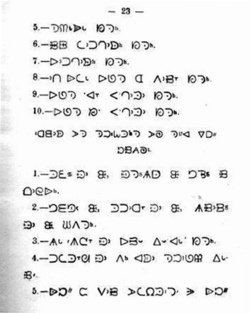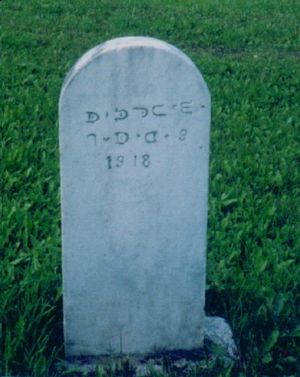Carrier syllabics facts for kids
Quick facts for kids Carrier syllabics |
|
|---|---|
 |
|
| Type | graphically moraic alphabet |
| Spoken languages | Carrier (Dakelh) |
| Created by | Adrien-Gabriel Morice |
| Time period | Created in 1885, with its usage beginning to fade in the 1920s |
| Sister systems | Cree syllabary, which also influenced the design of the letters |
| Note: This page may contain IPA phonetic symbols in Unicode. | |
Carrier syllabics (ᑐᑊᘁᗕᑋᗸ, Dʌlk'ʷahke, meaning toad feet) is a special writing system. It was created by a man named Adrien-Gabriel Morice for the Carrier language, also known as Dakelh. This script was inspired by another writing system called Cree syllabics. It's part of a group of writing systems used by Indigenous peoples in Canada.
History of Carrier Syllabics
The Dakelh people, who speak the Carrier language, used to be very good at reading and writing this script. People even wrote messages on trees using Carrier syllabics! Adrien-Gabriel Morice, the creator of the script, also published a newspaper in syllabics from 1891 to 1894. Sometimes, people even wrote Latin and English words using this system.
However, around 1920, the use of Carrier syllabics started to decline. This happened because the Carrier language was unfortunately banned from local schools. Instead, for things like prayer books, the Carrier language began to be written using a different form of the Latin alphabet (the alphabet we use for English). This new way of writing used English sounds for letters.
The change happened very quickly. It was so sudden that parents would write in syllabics, but their children would write using the new Latin alphabet. This meant that parents and children often couldn't understand each other's writing!
In the 1960s, a group called the Carrier Linguistic Committee (CLC) in Fort St. James created a standard way to write the Carrier language using the Latin alphabet. Today, this is the most common way to write the language. However, many people still feel that Carrier syllabics is a more important part of their culture and history.
How Carrier Syllabics Works
Carrier syllabics is designed in a clever way. Each symbol usually represents a whole syllable, which is a sound like "ba" or "ko."
Here's how it generally works:
- Symbols that start with the same consonant sound (like 'p' or 't') often look similar.
- To show different vowel sounds (like 'a', 'e', 'i', 'o', 'u'), the basic symbol might be rotated or flipped.
- Sometimes, a small mark, called a diacritic, is added in the middle of the symbol to show a specific vowel sound. For example, a short line might mean 'e', and a dot might mean 'i'.
- There are also special symbols for single consonant sounds that don't have a vowel right after them.
- The script is written from left to right, just like English.
- When it was first used, the spacing between words wasn't always very clear.
- For punctuation, Morice used the same marks that are used in the Latin alphabet, like commas and periods.
Carrier Syllabics in Computers
Carrier syllabics has been added to Unicode. Unicode is a system that allows computers all over the world to understand and display text from different languages and writing systems. This means that Carrier syllabics can be used on computers, just like other languages.


